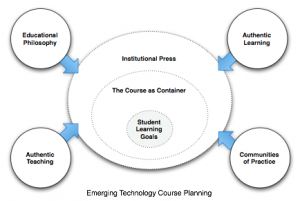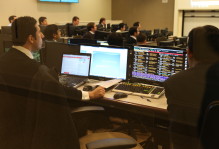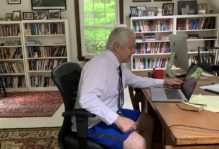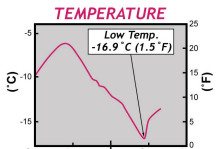Course Planning for Emerging Technology
A colleague of mine recently likened the course planning process to what goes on inside a sausage factory:
Over a century ago, the German statesman Otto Von Bismarck supposedly said, “If you like laws and sausages, you should never watch either one being made.” Same point can be made about the way I construct course syllabi…
While some folks may be shocked by realities of how faculty members plan their courses, I think there is real value to opening up the process. In that spirit, I’m planning to use this blog to reflect on my activities in preparing the Emerging Technologies in Education course that I’m planning for the fall. The planning model that I use looks something like this.

For me, course planning involves balancing three sets of interlocking goals: the learning goals of the individual students, the constraints (and affordances) of accomplishing those goals in a credit-bearing college course, and the “institutional press” of conducting the class within a specific institutional culture. When I plan a class, I try to structure our time together in a way that does justice to the complexity of these three sets of expectations. In a perfect world, the goals would be largely aligned, but in the real world of practice they seldom are.
As a course planner, I make decisions about structure, sequence, timing, grading and the myriad of other details based on my individual interpretation of the context of the class. There are at least four lenses that I use to focus on the particulars of a class.
- Educational Philosophy: Since the earliest scientific studies on curriculum, planners have noted that course design is a reflection of individual educational philosophy, and there is tremendous variation in the fundamental world views that shape teachers’ decisions. While my practice draws on a variety of perspectives–liberal education, progressivism, sometimes even behaviorism–my primary decision-making lenses are humanistic education and individualized instruction.
- Authentic Learning: As an intellectual and genetic descendent of John Dewey, I’m committed to building classes that advance authentic learning: learning that uses real-world problems and projects and that allow students to explore and discuss these problems in ways that are relevant to them.
- Authentic Teaching: One of the dangers of a scientific approach to teaching and learning is that it devalues the relationship between teacher and learner. In planning courses, I try to find topics, techniques and problems that connect to my genuine interests and concerns. In Parker Palmer’s terms: “Our deepest calling is to grow into our own authentic self-hood, whether it conforms to some image of who we ought to be. As we do so, we will also find the joy that every human being seeks–we will also find our authentic service in the world. True vocation joins self and service, as Fredrick Buechner asserts when he defines vocation as ‘the place where your deep gladness meets the world’s deep need.’”
- Communities of Practice: I’ve come agree with John Seeley Brown that one of the major goals of education is to bring students into contact with divergent communities with distinct understanding of knowledge and distinct ways of judging what is interesting, valid and significant. The focus of a community of practice is “learning to be” rather than merely mastering a body of knowledge. A major question in my courses is what does it mean to be an effective learner, citizen, teacher or administrator in a time of unparalleled technological change.
Translating those broad principles into practice—a set of activities and interactions, bounded by time and constrained by the realities of “institutional press”—make the course planning process an enormously complex one, but one that constitutes the heart of effective teaching.




No comments.
Comments are currently closed. Comments are closed on all posts older than one year, and for those in our archive.